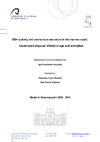Identificador persistente para citar o vincular este elemento:
https://accedacris.ulpgc.es/handle/10553/7224
| DC Field | Value | Language |
|---|---|---|
| dc.contributor.advisor | Packard, Theodore T. | - |
| dc.contributor.advisor | Gómez, May | - |
| dc.contributor.author | Fernández-Urruzola, Igor | - |
| dc.date.accessioned | 2012-04-10T08:55:10Z | - |
| dc.date.accessioned | 2018-05-15T10:56:32Z | - |
| dc.date.available | 2012-04-10T08:55:10Z | - |
| dc.date.available | 2018-05-15T10:56:32Z | - |
| dc.date.issued | 2010 | en_US |
| dc.identifier.uri | https://accedacris.ulpgc.es/handle/10553/7224 | - |
| dc.description | Máster en Oceanografía | en_US |
| dc.description.abstract | Ammonium (NH4+) release by bacterial remineralization and heterotrophic grazers determines the regenerated fraction of phytoplankton productivity, so the measurement of NH4+ excretion in marine organisms is necessary to characterize both the magnitude and the efficiency of the nitrogen cycle. Glutamate dehydrogenase (GDH) is largely responsible for NH4+ formation in crustaceans and consequently should be useful in estimating NH4+ excretion by marine zooplankton.<br />Here, we address body size and starvation as sources of variability on the GDH to NH4+ excretion ratio (GDH/RNH4+). We found a strong correlation between the RNH4+ and the GDH activity (r2 = 0.87, n = 41) during growth. Since GDH activity maintained a linear relation (b = 0.93) and RNH4+ scaled exponentially (b =0.55) in well fed mysids, the GDH/RNH4+ ratio increased with size. However, the magnitude of its variation increased even more when adult mysids were starved. In this case, the GDH/RNH4+ ratio ranged from 11.23 to 102.41. | en_US |
| dc.language | eng | en_US |
| dc.relation | Estudio de Un Nuevo Modelo Mecanistico Para El Metabolismo Del Zooplancton | en_US |
| dc.subject | 251001 Oceanografía biológica | en_US |
| dc.subject.other | Glutamate dehydrogenase | en_US |
| dc.subject.other | Ammonium excretion | en_US |
| dc.subject.other | Leptomysis lingvura | en_US |
| dc.subject.other | Starvation | en_US |
| dc.subject.other | Body size | en_US |
| dc.title | GDH activity and ammonium excretion in the marine mysid "Leptomysis lingvura": effects of age and starvation | en_US |
| dc.type | info:eu-repo/semantics/masterThesis | en_US |
| dc.type | MasterThesis | en_US |
| dc.compliance.driver | 1 | es |
| dc.contributor.facultad | Facultad de Ciencias del Mar | en_US |
| dc.identifier.absysnet | 659288 | - |
| dc.identifier.crisid | - | - |
| dc.investigacion | Ciencias | en_US |
| dc.rights.accessrights | info:eu-repo/semantics/openAccess | es |
| dc.type2 | Trabajo final de máster | en_US |
| dc.description.notas | Máster en Oceanografía ; 2008-2010 | en_US |
| dc.utils.revision | Sí | en_US |
| dc.identifier.ulpgc | Sí | en_US |
| dc.contributor.buulpgc | BU-BAS | en_US |
| item.grantfulltext | open | - |
| item.fulltext | Con texto completo | - |
| crisitem.author.orcid | 0000-0001-7287-3503 | - |
| crisitem.author.fullName | Fernández Urruzola, Igor | - |
| crisitem.project.principalinvestigator | Gómez Cabrera, María Milagrosa | - |
| crisitem.advisor.dept | GIR ECOAQUA: Ecofisiología de Organismos Marinos | - |
| crisitem.advisor.dept | IU de Investigación en Acuicultura Sostenible y Ec | - |
| crisitem.advisor.dept | GIR ECOAQUA: Ecofisiología de Organismos Marinos | - |
| crisitem.advisor.dept | IU de Investigación en Acuicultura Sostenible y Ec | - |
| crisitem.advisor.dept | Departamento de Biología | - |
| Appears in Collections: | Trabajo final de máster | |
Page view(s)
88
checked on May 18, 2024
Download(s)
112
checked on May 18, 2024
Google ScholarTM
Check
Share
Export metadata
This item is licensed under a Creative Commons License

